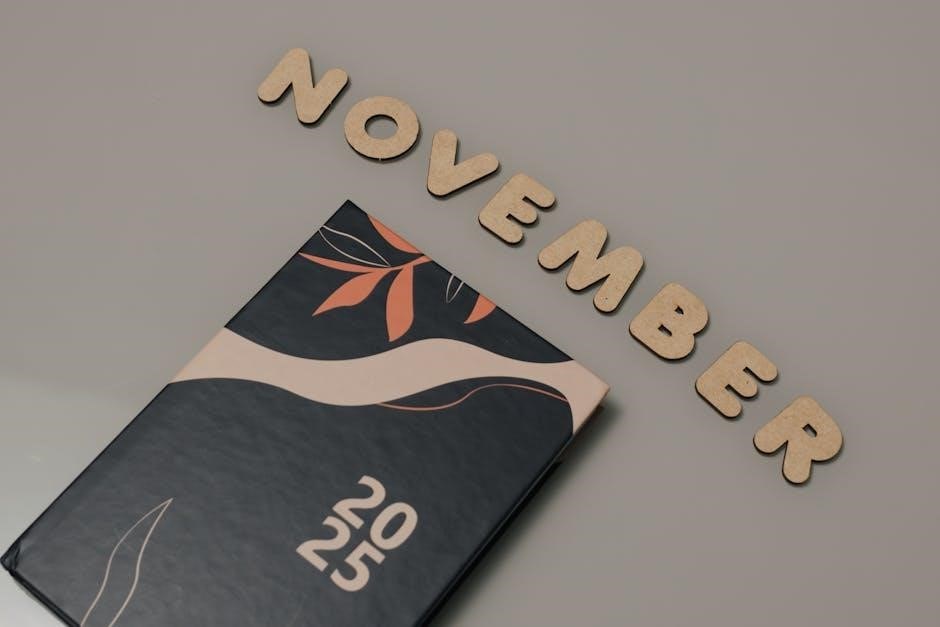The graphic adaptation of Anne Frank’s Diary‚ authored by Ari Folman and illustrated by David Polonsky‚ offers a visual reinterpretation of the classic Holocaust memoir.
Published in 2017 by Knopf Doubleday‚ it remains faithful to the original while adding emotional depth through illustrations.
This adaptation‚ authorized by the Anne Frank Foundation‚ is widely available as a free PDF download‚ making it accessible for educational purposes.
Despite its educational value‚ it has faced controversy in some schools due to mature themes.
The graphic novel bridges generations‚ ensuring Anne’s story continues to resonate with modern readers.
Overview of the Original Diary
Anne Frank’s Diary is a deeply personal and poignant account of a young girl’s experience during World War II. Written between 1942 and 1944‚ the diary chronicles Anne’s life in hiding with her family in Amsterdam to escape Nazi persecution. The diary captures her hopes‚ fears‚ and observations‚ offering a vivid portrayal of life under oppressive circumstances. Discovered after Anne’s tragic death‚ the diary was published by her father‚ Otto Frank‚ and has become one of the most important books of the 20th century‚ transcending generations with its universal message of humanity and resilience.
The Concept of a Graphic Adaptation
The graphic adaptation of Anne Frank’s Diary transforms her poignant story into a visual narrative‚ enhancing accessibility for modern readers. Created by Ari Folman and illustrated by David Polonsky‚ this adaptation‚ authorized by the Anne Frank Foundation‚ maintains the diary’s emotional depth while adding layers of visual storytelling. It introduces Anne’s experiences to a new generation‚ blending historical context with vivid illustrations to make the Holocaust’s impact more tangible and relatable‚ ensuring her legacy endures through a fresh‚ engaging medium.
Purpose and Target Audience
The graphic adaptation of Anne Frank’s Diary aims to make her story more accessible‚ especially to younger readers and visual learners. By combining text with illustrations‚ it bridges generational gaps‚ ensuring her message resonates anew. The free PDF download option expands its reach‚ making it a valuable educational tool for schools and educators. This adaptation is designed for readers seeking a deeper emotional connection through visual storytelling‚ while remaining faithful to Anne’s original words and experiences during World War II.
Background of the Graphic Novel
Anne Frank’s Diary: The Graphic Adaptation was published in 2017 by Knopf Doubleday Publishing. It was collaboratively created by Ari Folman and David Polonsky‚ with authorization from the Anne Frank Foundation.
Creators and Collaborators
The graphic adaptation of Anne Frank’s Diary was created by Israeli filmmaker and writer Ari Folman and illustrator David Polonsky. Ari Folman‚ known for his work on Waltz with Bashir‚ adapted Anne’s diary into a visual narrative. David Polonsky’s expressive illustrations brought the story to life‚ blending historical accuracy with emotional depth. The project was authorized by the Anne Frank Foundation‚ ensuring fidelity to the original diary. This collaboration resulted in a powerful medium that introduces Anne’s story to new generations while preserving its historical and emotional significance.
Publication Details
Anne Frank’s Diary: The Graphic Adaptation was published in 2017 by Knopf Doubleday Publishing Group. The graphic novel is available in English and spans 159 pages. It is categorized under Comics & Graphic Novels‚ making it accessible to a broad audience. The book is available as a free PDF download on platforms like Z-Library and Internet Archive‚ ensuring widespread accessibility. Its publication marked a significant milestone in adapting Anne Frank’s story for modern readers while maintaining the original’s emotional and historical integrity.

- Publisher: Knopf Doubleday Publishing Group
- Year: 2017
- Language: English
- Format: PDF
- Availability: Free download on multiple platforms
Authorization by the Anne Frank Foundation
The graphic adaptation of Anne Frank’s Diary was officially authorized by the Anne Frank Foundation in Basel. This endorsement ensures the adaptation remains faithful to the original diary’s intent and historical accuracy. As the first authorized graphic biography‚ it uses direct text from the diary‚ maintaining the integrity of Anne’s voice. The foundation’s approval underscores the adaptation’s educational value‚ making it a trusted resource for introducing Anne’s story to new generations while preserving her legacy for future readers.
Key Themes and Messages
The graphic adaptation explores themes of hope‚ resilience‚ and humanity‚ set against the backdrop of the Holocaust. It highlights the struggles of identity and coming of age during war‚ emphasizing Anne’s indomitable spirit and the universal message of hope amidst despair.
The Holocaust and Its Impact
The graphic adaptation vividly portrays the Holocaust’s horrors‚ capturing the atrocities faced by Jews during World War II. It illustrates Anne’s experiences in hiding‚ the Nazi occupation‚ and the eventual betrayal. The visuals emphasize the emotional and psychological toll on Anne and her family‚ offering a poignant reminder of the Holocaust’s devastating impact. The graphic novel serves as a powerful visual documentation of one of history’s darkest periods‚ ensuring the lessons of the Holocaust remain accessible and unforgettable for new generations of readers.
Hope‚ Resilience‚ and Humanity
The graphic adaptation underscores Anne’s unwavering hope and resilience amidst unimaginable suffering. Her diary entries‚ visually interpreted‚ reveal a young girl clinging to humanity in the darkest times. The illustrations emphasize her belief in a better future‚ even as the Holocaust raged on. This visual narrative captures her determination to maintain dignity and compassion‚ offering a deeply human perspective on survival and hope. The adaptation ensures these timeless themes resonate with readers‚ preserving Anne’s indomitable spirit for future generations.
War‚ Identity‚ and Coming of Age
The graphic adaptation vividly portrays Anne’s personal growth and self-discovery amidst the chaos of war. The Holocaust’s shadow looms large‚ yet Anne’s diary entries reveal her struggle to maintain identity and hope. The visuals capture her internal conflicts‚ from adolescence to the realization of her Jewish heritage. The graphic format brings her aspirations and fears to life‚ making her journey relatable. This adaptation highlights the universal themes of identity and resilience‚ offering a poignant reflection on growing up in the face of unimaginable adversity.

Illustrations and Visual Storytelling
Detailed‚ expressive illustrations by David Polonsky bring Anne Frank’s story to life‚ enhancing emotional depth and historical context.
The visual narrative complements the diary’s text‚ creating a powerful‚ immersive experience.
This artistic approach ensures the graphic adaptation remains faithful to the original while offering a fresh‚ engaging perspective.
Style and Artistic Approach
The graphic adaptation features striking illustrations by David Polonsky‚ blending expressive visuals with a muted color palette to evoke the somber essence of Anne Frank’s story.
Polonsky’s artwork captures the emotional depth of the diary‚ using shadows and symbolism to convey the horrors of the Holocaust.
Ari Folman’s adaptation remains faithful to the original text while introducing a modern visual language.
The illustrative style bridges historical accuracy with creative interpretation‚ making the narrative accessible to a new generation.
This artistic approach ensures the story’s emotional resonance is preserved and amplified through visual storytelling.
How Illustrations Enhance the Narrative
David Polonsky’s illustrations in Anne Frank’s Diary: The Graphic Adaptation vividly interpret the emotional and historical depth of Anne’s story.
The visuals add layers of meaning‚ transforming the written word into a powerful visual experience.
By depicting scenes from Anne’s life‚ the illustrations make the narrative more accessible‚ especially for younger readers.
They also emphasize the contrasts between Anne’s inner world and the harsh realities of the Holocaust.
The artwork complements the text‚ creating a deeply moving and engaging reading experience that resonates with readers of all ages.
Visual Representation of Historical Events
The graphic adaptation vividly portrays historical events through David Polonsky’s evocative illustrations‚ bringing Anne Frank’s experiences to life.
The visuals capture the claustrophobia of the Secret Annex and the horrors of the Holocaust‚ making history more tangible for readers.
The artwork bridges the gap between past and present‚ ensuring the atrocities of WWII remain unforgettable.
By illustrating key moments‚ the graphic novel provides a poignant visual narrative of Anne’s life and legacy‚ preserving history for future generations.

Reception and Reviews
The graphic adaptation has received widespread acclaim for its faithful portrayal of Anne Frank’s story‚ with many praising its emotional depth and educational significance.
However‚ some have criticized its mature themes‚ leading to its removal from certain school curricula despite its historical importance and literary merit.
Positive Feedback and Acclaim
The graphic adaptation of Anne Frank’s Diary has garnered widespread acclaim for its ability to bring a fresh‚ visual perspective to the classic memoir.
Reviewers praise its faithful adaptation‚ maintaining the emotional depth of the original while adding layers of visual storytelling.
The illustrations by David Polonsky have been particularly commended for their expressive and haunting beauty.
Educators and readers alike have embraced it as a powerful tool for engaging new generations with Anne Frank’s story.
Its availability as a free PDF download has further amplified its reach and educational impact.
Controversies and Challenges
The graphic adaptation of Anne Frank’s Diary has faced challenges‚ with some schools and communities questioning its suitability due to mature themes.
Critics argue that certain visual elements and references in the graphic novel may not be appropriate for younger audiences.
In some cases‚ the book has been removed from school libraries following complaints from conservative groups.
Despite this‚ supporters emphasize its educational value and the importance of preserving Anne Frank’s story.
The debates highlight the balance between censorship and the need for open discussions about historical events.
Educational and Cultural Significance
The graphic adaptation of Anne Frank’s Diary holds profound educational and cultural value‚ offering a visual and accessible way to engage with one of history’s most important stories.
It serves as a powerful tool for teaching younger generations about the Holocaust and its impact on humanity.
The adaptation’s authorization by the Anne Frank Foundation ensures its authenticity and educational integrity.
By making the PDF version freely available‚ it democratizes access to this vital piece of history‚ fostering empathy and understanding worldwide.
This work continues to inspire reflection on tolerance and human rights.

Downloading the Graphic Adaptation for Free
The graphic adaptation of Anne Frank’s Diary is available as a free PDF download from platforms like Z-Library‚ offering easy access for readers worldwide.
This digital format ensures the story’s reach is extended‚ enabling a new generation to engage with its powerful message.
The free download option‚ authorized by the Anne Frank Foundation‚ makes this historical narrative accessible to all.
Availability of the PDF Version
The PDF version of Anne Frank’s Diary: The Graphic Adaptation is widely available for free download on platforms like Z-Library and Internet Archive.
With a file size of 17.21 MB‚ it is easily accessible for readers worldwide.
The PDF format ensures compatibility across devices‚ making it simple to read on smartphones‚ tablets‚ or computers.
Authorized by the Anne Frank Foundation‚ this digital edition is a convenient way to explore the story.
Its availability promotes education and ensures Anne’s legacy reaches new generations.
Platforms for Free Download
The graphic adaptation of Anne Frank’s Diary is available for free download on various platforms‚ including Z-Library and Internet Archive.
These websites offer the PDF version in multiple formats‚ ensuring accessibility for readers worldwide.
Additionally‚ platforms like Libby and OverDrive provide digital access through libraries.
Some torrent sites and comic book forums also host the file‚ though users should verify authenticity.
This widespread availability ensures the story reaches a broad audience‚ promoting education and historical awareness.
Ethical Considerations of Free Access
Free access to Anne Frank’s Diary: The Graphic Adaptation raises ethical concerns about copyright and compensation for creators.
While the Anne Frank Foundation authorizes the adaptation‚ unauthorized distributions may infringe on rights.
Libraries and educational platforms offer ethical access‚ supporting both creators and learners.
Users are encouraged to download responsibly‚ respecting intellectual property and supporting authors.
This balance ensures the story’s educational impact while upholding ethical standards in publication and distribution.

Anne Frank’s Diary: The Graphic Adaptation preserves her legacy‚ offering a poignant visual narrative of resilience and hope.
Its free PDF availability ensures educational access‚ honoring her story’s enduring impact.

The Lasting Legacy of Anne Frank’s Story
Anne Frank’s Diary remains a timeless testament to hope and humanity amidst unimaginable adversity.
The graphic adaptation ensures her story reaches new generations‚ preserving its historical and emotional significance.
By blending visual storytelling with her original words‚ it keeps her legacy alive‚ inspiring reflection on freedom‚ identity‚ and resilience.
The free PDF availability widens access‚ ensuring her voice continues to educate and move readers worldwide‚ solidifying her impact on global consciousness and historical remembrance.
The Role of the Graphic Adaptation in Preserving History
The graphic adaptation of Anne Frank’s Diary serves as a powerful tool in preserving history by transforming her written testimony into a visually engaging narrative.
It ensures that the atrocities of the Holocaust remain accessible and relatable for future generations.
The free PDF version allows widespread dissemination‚ making it easier for educators and learners to engage with this crucial historical account.
By blending text with illustrations‚ it maintains the Diary’s authenticity while offering a fresh perspective.
This adaptation ensures the Holocaust’s lessons are not forgotten‚ inspiring empathy and understanding globally.
Final Thoughts on the Importance of the Work
The graphic adaptation of Anne Frank’s Diary is a vital work that ensures her story remains relevant and accessible to new generations.
By blending historical truth with visual storytelling‚ it fosters empathy and understanding of the Holocaust’s horrors.
The free PDF version democratizes access‚ making it a valuable educational tool worldwide.
Despite controversies‚ the work’s importance lies in its ability to spark dialogue and reflection.
It stands as a testament to Anne’s enduring legacy‚ reminding us of the human cost of prejudice and the power of hope.
